![]()
SAILING TO JAMBŪDVĪPA
Did Lord Varaha Lift an Earth Globe?
BY: MAYESVARA DASA
Feb 11, 2018 —IRELAND (SUN) — A Reply To Ramesvara dasa.
Among Vaishnavas the story of Lord Varaha lifting the Earth from the Garbhodaka Ocean is well known; but what is not so well known is the nature of the Earth in question. Did Lord Varaha lift an Earth globe, or does Srimad Bhagvatam describe a very different conception of the Earth? In this paper we will argue that Srimad Bhagavatam describes Lord Varaha lifting the entire Bhu-mandala (Earth circle). Bhu-mandala is described as a massive circular plane that is 4 billion miles in diameter and crosses the center of the universe. The Varaha lila has obvious implications for our current understanding of the Earth as a globe in space and particularly in relation to how the Earth circle should be depicted and explained from the Temple of Vedic Planetarium when it eventually opens to the world sometime in 2022.
The following text appeared on a Facebook page and presents an argument by Ramesvara dasa, a disciple of Srila Prabhupada in favour of the globe idea:
-
"Srila Prabhupada, the source of absolute knowledge incarnate, directed in detail the art paintings for his books with great concern that they be authentic and not otherwise ruin his mission of delivering the Absolute Truth in book form.
He had the artists paint Lord Varaha lifting the earth as a globe, not as flat.
He could have directed the artists either way. That should be good enough for any true Prabhupada-anuga".
Your aspiring servant, Ramesvara dasa
(Facebook: Vedic Cosmology and the Srimad Bhagavatam's 5th Canto in Mathura Vrindavan, December 23 2016 at 5:57am)
In our previous papers we have presented evidence as to why Srila Prabhupada may have referred to the Earth as a globe when the Srimad Bhagavatam describes the Earth in a very different way. We won't repeat the arguments here, but the relevant papers can be found here and here. For those unfamiliar with our papers on Sampradaya Sun we recommend reading the links above, otherwise the present paper will lack context.
In previous papers we have presented the argument that although Srila Prabhupada initiated a plan in 1975 to revive Vedic cosmology via the Mayapur Temple of Vedic Planetarium, a comprehensive conception of Bhu-mandala (the Vedic concept of the Earth) had not been established by the time of Srila Prabhupada's departure in 1977. In the absence of a comprehensive conception of Bhu-mandala, Srila Prabhupada had simply spoken of the Earth in the conventional sense as a globe in space. Thus, in all of the historical narrations that are mentioned in Srimad Bhagavatam involving places upon the Bhu-mandala such as Varahadeva lifting the Earth, or Prithu Maharaja leveling the Earth, Srila Prabhupada generally translates the Sanskrit names for the Earth such as Bhu-mandala, ksiti-mandala, Bhu-gola, etc., as the 'Earth globe' or 'Earth planet.'
Perhaps to simplify things for the modern reader, Srila Prabhupada did not differentiate between these two very different ideas of the Earth. In his translation of Srimad Bhagavatam, Srila Prabhupada was content to inform us that Bhu-mandala refers to the 'Earth planet' or the 'Earth globe.' After all, for anyone unfamiliar with the Sanskrit names and descriptions of the various places through-out the universe, one has to initially know merely that Bhu-mandala refers to the Earth, whilst Surya refers to the sun, Chandra to the moon, etc. In translating Bhu-mandala as 'the Earth planet,' Srila Prabhupada is simply informing the reader that the name Bhu-mandala corresponds to the Earth (and hence to where we stand in the Vedic cosmos). Thus Srila Prabhupada generally translates the many Sanskrit names for the Earth or even different places on the Bhu-mandala (such as Bharata-varsha) as 'this planet.' However, one must be aware that the Vedic concept of the Earth, is radically different from our modern conception of a globe-shaped planet floating in dark space, and the distinction between the two is something that has only gradually emerged. Particularly after 1975 when Srila Prabhupada initiated his amazing plan for presenting the Vedic cosmos at the Mayapur Temple of Vedic Planetarium, questions regarding the nature of the Earth began to emerge. The plan to present the Vedic cosmos would obviously require a greater study of the nature of Bhu-mandala since an explanation the movements of planets creating day and night, seasons, eclipses etc., all required to be explained from the Vedic perspective.
The idea that came to Srila Prabhupada in 1975 of presenting Srimad Bhagavatam's cosmological descriptions via a Temple of Vedic Planetarium was a long away off from when Srila Prabhupada first began his translation of Srimad Bhagavatam whilst residing at the Radha-Damodar temple in Vrindavana India (the first volume of Srimad Bhagavatam was published in 1962). The presentation of Vedic cosmology at the planetarium would obviously require a deep study of all the details of the subject, and particularly the description of Earth which to the modern reader seems more mythological than realistic, and seems to have nothing in common with our contemporary understanding of the Earth as planet floating in space.
In the beginning, Srila Prabhupada seemed content to inform the reader that the many Sanskrit names used for Bhu-mandala (Ksiti, Prthivi, Mahi, Dhara, etc.) correspond to the Earth; Srila Prabhupada referred to the Earth using the modern language of 'Earth planet' or 'Earth globe'. Although Srila Prabhupada spoke of the Bhu-mandala (Earth) using the conventional language and concept of the Earth as a globe or planet, the idea that this brings to mind is very different from how Srimad Bhagavatam actually describes the Earth and our location upon the great Earth circle in an area called Bharata-varsha. When we look at the description of Bhu-manadala in chapters 16-26 of Srimad Bhagavatam we see that the Earth described has actually nothing in comparison with the idea that Earth is a planet floating in space. The Vedic and modern conceptions of the Earth are, in fact, two completely different conceptions of reality. The Vedic concept of the Earth is not that of a globe in space; rather the Earth is described as a vast circular plane, of which are own area is only a tiny part. One must bear this in mind when considering Srila Prabhupada's terminology; otherwise, when we read Srila Prabhupada's translation and purports to Srimad Bhagavatam, we may naturally think that any reference to the Earth is referring to the so-called Earth globe. For example, in SB 3.13.41 which describes the pastime of Lord Varaha lifting the Earth we read:
-
"O Lord, as the peaks of great mountains become beautiful when decorated with clouds, Your transcendental body has become beautiful because of Your lifting the earth on the edge of Your tusks." (SB 3.13.41)
Although we may have the idea here that Lord Varaha was lifting an Earth globe, in fact, the Lord was lifting the entire Bhu-mandala. Here the name Bhu-mandala is clearly used: saukaram bhu-mandalenatha data dhritena te, "in the form of a boar you lifted Bhu-mandala on your tusk." The Sanskrit words are as follows: saukaram — the boar; bhu-mandalena—by the earth planet; atha—now; data—by the tusk; dhrtena—sustained by: te—Your.
When we come across any reference to the Earth in Srimad Bhagavatam, we must understand that the Earth in question is the one described by Sukadeva Goswami in chapters 16-26 of the fifth canto. Although the Earth described here is certainly not a description of a globe floating in space, throughout the course of his Srimad Bhagavatam translation and purports, Srila Prabhupada simply translates Sanskrit words for the Earth using the modern terminology of 'Earth globe' and 'Earth planet.' Again, Srila Prabhupada's purpose is to help us understand that in the Vedic scheme of things we are located in Bhu-mandala (the Earth), but unless one is conscious of the difference in the two ideas of the Earth, one may think that the Bhu-mandala and the modern Earth globe idea are the same thing, when they are actually two very different concepts. For example:
-
"After this, the king of all kings, Maharaja Prthu, leveled all rough places on the surface of the globe by breaking up the hills with the strength of his bow. By his grace the surface of the globe almost became flat." (SB 4.18.29)
Here Srila Prabhupada translates the Sanskrit name for the Earth as 'surface of the globe,' and we may naturally think of the Earth as a globe floating in dark space. However, the Sanskrit word for Earth that is used here is specifically a reference to the Bhu-mandala as seen in the text itself: curnayan sva-dhanush-kotya giri-kutani raja-rat bhu-mandalam. The meaning of the Sanskrit words is as follows: curnayan—making into pieces; sva—his own; dhanuh-kotya—by the power of his bow; giri—of the hills; kutani—the tops; raja-rat—the emperor; bhu-mandalam—the whole earth. That King Prithu ruled over the entire Bhu-mandala is confirmed in the following verse:
-
"We have heard that although powerful kings like Maharaja Prthu and Maharaja Gaya achieved proprietorship over the seven dvipas." (SB 8.19.23)
The Sanskrit words are as follows: sapta-dvipa-adhipatayah—those who are proprietors of the seven islands; nripah—such kings; vainya-gaya-adayah—Maharaja Prithu, Maharaja Gaya and others. The term sapta-dvipa refers to the inhabited area of the Earth plane comprising seven islands arranged in a unique formation of concentric circles that expand like ripples on water across the surface of the Earth for a distance of over 200 million miles. This tells us something about the nature of the Earth in question. To help us understand that King Prithu's pastimes happened on the Earth, and not some other place in the Vedic universe, Srila Prabhupada refers to King Prithu leveling 'the surface of the globe.' Although Srila Prabhupada speaks of the Earth using our familiar word 'globe', we must be conscious that the Earth in question is actually of a very different nature. King Prithu's reign was over the entire 200 million-mile inhabited area of the vast Earth circle. The illustration below shows the extent of King Prithu's kingdom over the surface of Bhu-mandala (Earth circle):
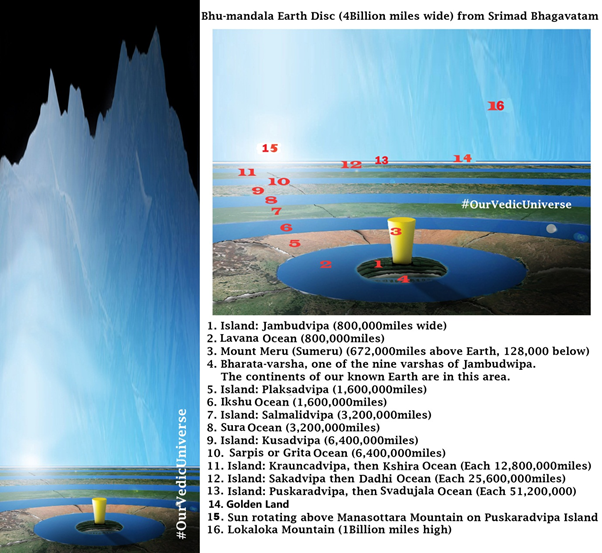
Although King Prthu ruled the entire Bhu-mandala, perhaps for simplification Srila Prabhupada refers to the Earth in our familiar language as a globe. There are hundreds of similar examples like this where Srila Prabhupada has translated the name Bhu-mandala or equivalent Sanskrit terms for Bhu-mandala (Mahi, Prthivi, etc) as 'Earth globe' or 'Earth planet'. One must be conscious of the difference in the two concepts in order not to make the mistake of thinking that Srimad Bhagavatam is describing the Earth to be a globe-shaped planet floating in space. The Bhu-mandala or Bhu-gola as described above is 4 billion miles in diameter and stretches across the center of the universe. It is a great cosmic circle held by Ananta-sesha, not a small globe floating in space. The Bhu-mandala is characterized by having an inhabited area of seven islands and seven oceans measuring hundreds and millions of miles. The smallest island is called Jambudwipa and is a mere 800,000 miles in breadth. Our known area of the Earth is part of the area called Bharata-varsha and is located at the southern end of Jambudwipa.
Since our particular area of the Bhu-mandala is located in an area called Bharata-varsha, Srila Prabhupada (again with the purpose of informing the modern reader of where we stand in the Vedic cosmos) would sometimes also refer to Bharata-varsha itself as 'this planet' or 'this planet Earth.' For example:
-
"Rishabhadeva was the son of King Nabhi and the grandson of King Agnidhra, and he was the father of King Bharata, after whose name this planet earth was called Bharata-varsha" (SB 2.7.10 purport)
Srila Prabhupada uses the terminology of 'Earth planet' or 'Earth globe' because that is how the modern person speaks and thinks of the Earth. In the above purport Srila Prabhupada is helping the reader to understand that the histories of the personalities mentioned in the above verse took place in Bharata-varsha which for reference point can be taken as 'this planet Earth'. For all the reader knows, Bharata-varsha could refer to any place in the universe, so Srila Prabhupada is just informing the reader of where this place is located using the terminology that a modern reader can relate to: 'this Earth planet.' However, when one looks at the specific description of Bharata-varsha, it is merely one place among many on the surface of the great Earth that expands to a diameter of 4 billion miles.
If we are to follow Srila Prabhupada's instruction to make an accurate model of the Vedic Universe then Bharata-varsha has to be presented as it is described—a division of land located at the southern end of Jambudwipa:
-
"Bharata-varsha: This part of the world is also one of the nine varshas of the Jambudvipa." (SB 1.16.12 purport)
The image below shows the location of Bharata-varsha at the southern side of the island of Jambudwipa. Jambudwipa is a super-sized continent with a diameter of 800,000 miles. Just as Europe is divided into several countries, so this great land mass of Jambudwipa is divided into nine sections called varshas. Our Earth area is located in the Southern varsha called Bharata. Our entire known Earth is just one small section of Bharata-varsha. Jambudwipa itself is surrounded by other areas of the vast Earth plane:
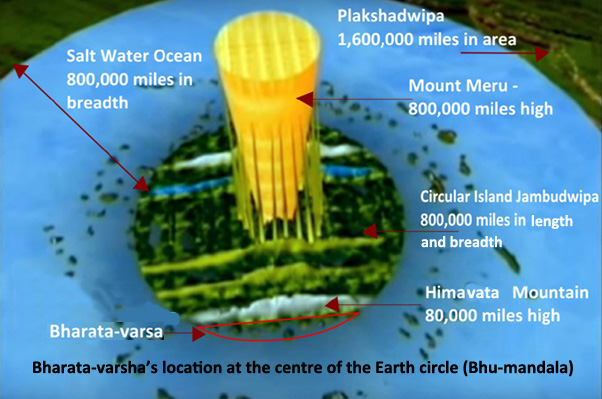
Bharata-varsha's location at the southern side of Jambudwipa
Srimad Bhagavatam thus presents the idea that our known Earth is surrounded in all directions by other inhabited areas of the greater Earth plane. This idea of a continual Earth plane (based on the description of Srimad Bhagavatam) is what is meant to be displayed at the Mayapur Temple of Vedic Planetarium. Such a presentation requires refuting the idea that we live on a globe floating in space. There is otherwise, no verse, statement, concept, Sanskrit word, etc, that identifies either Bhu-mandala or Bharata-varsha as a globe floating in space. It simply doesn't exist.
However, since Srila Prabhupada refers to both Bhu-mandala and Bharata-varsha using the modern terminology of 'Earth globe' or 'planet Earth', one who is unaware of the specific description of Bhu-mandala as a 4 billion mile circular plane (and particularly one who is unaware of the location of Bharata-varsha upon the surface of the massive Bhu-mandala plane) may take the wrong impression from Srila Prabhupada's terminology that Srimad Bhagavatam is presenting the Vedic Earth in a way that is similar to the modern idea of Earth (as a round planet floating in space). The Vedic Earth is actually described as a great circular plane, not a small globe-shaped planet; and Bharata-varsha itself is located on the surface of Bhu-mandala (and thus cannot be a separate planet floating in space as we assume Earth to be). Our Earth area in Bharata-varsha is a part of the Bhu-mandala as a slice of tomato is part of a pizza. Since the slice of tomato is only part of the pizza, we should not think of the tomato as the entire pizza. Similarly, since Bharata-varsha is only part of the Earth (Bhu-mandala), we should not think that Bharata-varsha is the Earth in its entirety. Although Srila Prabhupada refers to Bharata-varsha as 'this planet Earth', we must appreciate that his intention is merely to give us some bearings; further study into the subject reveals that Bharata-varsha is only a small part of the greater Earth circle. Bhu-mandala is the Earth, and Bharata-varsha is just a small part of it.
On the basis of Srimad Bhagavatam's description of the Earth, we have begun to call into question the very idea that we live on a small globe-shaped planet floating in space. We have argued that the science supporting the globe can be refuted, and that the modern images of the Earth globe are fake. Certainly Srimad Bhagavatam does not describe Bharata-varsha as a globe floating in space. Devotees arguing in favour of the globe idea need to become aware of the original description of Bharata-varsha and its relation to the greater Earth plane; otherwise, to simply take Srila Prabhupada's words out of context in order to argue that Bharata-varsha corresponds with the assumed Earth globe of 24,900 miles is clearly a mistake in reasoning. Bharata-varsha actually has a measurement running into hundreds of thousands of miles. Like it or not, the result of this conflation of the names Bhu-mandala and Bharata-varsha with the assumed Earth globe is that an Earth globe has appeared in the Vedic cosmology out of nowhere. The uninformed reader is, therefore, under the false impression that the pastimes of Lord Krishna upon the Earth are by default referring to pastimes on an Earth globe concept. Thus one may think that Lord Varaha lifted the so-called Earth globe, and not the great Earth circle (Bhu-mandala) as it is described by Sukadeva Goswami. The question of Lord Varaha lifting the Earth actually came up during a discussion on 28 June 1977 between Srila Prabhupada and some disciples that he had engaged in the initial research for the planetarium. Tamala Krishna Goswami writes about this small group in the following letters:
-
"It may be interesting to know that one sannyasi here, Bhakti Prem Swami, who is a Sanskrit expert, as well and Yasodanandan Swami and myself are working under Srila Prabhupada's direction on chalking out the model for the planetarium." (Tamala Krishna Goswami Letter to Hamsaduta, June 25 1977, Vrindavana)
Again:
-
"The persons who were present at that meeting with Srila Prabhupada were not ordinary devotees. Bhakti Prem Maharaja is quite expert at Sanskrit, so much so that Srila Prabhupada feels confident that we do not have to look for a Sanskrit pandit for explaining how the planetarium should be arranged according to the Bhagavatam, now that we have found him. Dr. Svarupa Damodar is a scientist, and Srila Prabhupada has the greatest respect for his opinion. Yasodanandan Maharaja is an advanced sannyasi devotee, very knowledgeable in the philosophy. And I am simply a rascal. At least the opinions of the first three persons are valuable." (Tamala Krishna Goswami, Letter to Ramesvara dasa, July 22, 1977, Vrindavana)
Deciphering the fifth canto was basically an area of study that Srila Prabhupada handed over to his disciples:
-
"Prem Yogi [Bhakti-prema dasa] showed Srila Prabhupada some illustrations from the Srimad-Bhagavatam, Fifth Canto, and explained them briefly. Prabhupada was impressed with his proper understanding. Prabhupada showed him the Mayapur model and explained what we intended to do there. Srila Prabhupada then expressed his concern: "We must exactly follow the description of Bhagavatam. As we are going to spend many crores of rupees, and there will be those who will try to find fault in our presentation, 'Caesar's wife must be above suspicion.' I have explained whatever I could already in my books. Now my brain is no longer able to work properly. You young men can tax your brains to understand the Sanskrit and English descriptions and present them." (TKG's Diary: Prabhupada's Final Days, May 30 1977)
During a discussion between Srila Prabhupada and this small group of devotees, the question was raised as to whether Lord Varaha lifted a globe-shaped Earth or the entire Bhu-mandala:
-
Devotee (2): Srila Prabhupada, previously we painted in the art department... Just like Varaha lifted the earth, and the earth was a globe, and we showed also a globe of the earth. How does that relate to this? Previously, when we painted, we showed the earth a ball. So now the artists will be very confused. How it fell in the Garbha Ocean as a ball?
Yasodanandana: It depends on what we mean by earth. The Western conception of earth is just five continents and a few oceans, but according to Bhagavatam, earth means Jambudvipa, because earth is connected with Jambudvipa.
Devotee (2): So whole Jambudvipa fell.
Bhakti-Prema: Bhagavata describes the height of Himalayas, eighty thousand miles.
Prabhupada: No, about this earth globe.
Bhakti-Prema: About the earth it describes four billion miles.
Tamala Krishna: That means Jambudvipa.
Bhakti-Prema: No, that means complete earth, four billion miles. That is eight lakhs miles, Jambudvipa.
Tamala Krishna: Four billion is the universe.
Bhakti-Prema: Bhu-mandala.
Tamala Krishna: Bhu-mandala. Oh, the Bhagavatam describes Bhu-mandala as earth.
Prabhupada: Oh.
Yasodanandana: Bhumi.
Bhakti-Prema: ...has come right from the ocean, from the bottom of the ocean. Prabhupada: So explained there. Then this question is solved.
Tamala Krishna: Yes. The whole Bhu-mandala fell.
Bhakti-Prema: So the universe is round, and from bottom of the Garbhodaka ocean to top of Satyaloka there is four billion miles. Then the again, from east to west again is another four billion miles. Because Bhu-mandala is situated in between the earth.
Prabhupada: Explain. He'll explain.
(June 28 1977, Vrindavana)
Bhakti-prema dasa rightly points out that the diameter of the Earth is four billion miles, and that it was the entire Bhu-mandala (not an Earth globe) that fell into the Garbhodaka Ocean. Srila Prabhupada appears to accept this conclusion, as affirmed by Tamala Krishna Goswami:
-
Prabhupada: So explained there. Then this question is solved.
Tamala Krishna: Yes. The whole Bhu-mandala fell.
(June 28 1977, Vrindavana)
Bhakti-prema's understanding that Varaha lifted the entire Bhu-mandala is confirmed in Srimad Bhagavatam 3.13.41 which states: ca saukaram bhu-mandale natha data dhrtena te, "in the form of a boar you lifted Bhu-mandala on your tusk." Srila Prabhupada seemed to accept Bhakti-prema's presentation by saying: "So explained there [Srimad Bhagavatam]. Then this question is solved."
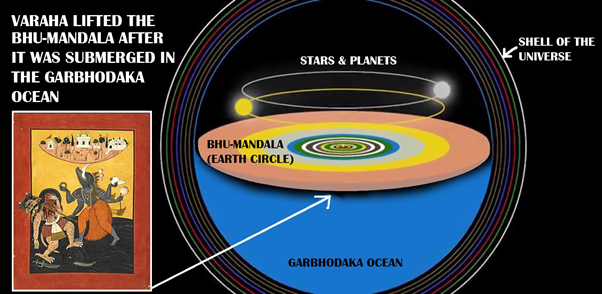
Lord Varaha lifting the Bhu-mandala
Bhakti-prema dasa also corrects the misunderstanding of Yasodanandana Prabhu and Tamala Krishna Goswami regarding Jambudwipa. Jambudvipa is the name of the central island of Bhu-mandala, and does not refer to the entire Earth itself. Referring the others to Bhakti-prema's explanation, Srila Prabhupada said, "he'll explain." Unfortunately, the following conclusion didn't arise: since the surface of the Earth is 4 billion miles, and the central island of Bhu-mandala is Jambudwipa which is 800,000 miles, then Bharata-varsha (which is part of the island of Jambudwipa) cannot be a separate globe-like planet floating in space. From the description provided, Bharata-varsha is just a tiny area that is situated on the Earth's massive plane; it is not a separate planet floating in space. This line of reasoning was never put to Srila Prabhupada for his consideration. The devotees involved here are not at fault as the process of inquiry into the nature of Bhu-mandala was really only beginning.
In any case, in answer to the original question of whether the artists should paint the Earth as a ball, Srila Prabhupada appears to have accepted Bhakti-prema's conclusion that Varaha lifted the entire Bhu-mandala, and not an Earth globe: "So explained there. Then this question is solved."
This conclusion, of course, implies no criticism of the artists involved at the time who did not know any better than to depict Bhu-mandala as a globe. However, it is a misunderstanding that should not be continued in future depictions of Lord Varaha, nor in lectures by preachers who wish to explain the pastime of Lord Varaha lifting the Earth. If we wish to understand the shape and size of the Earth that was lifted by Lord Varaha then we have to go to the original description of the Earth presented in chapters 16-26 of the fifth canto. When Sukadeva Goswami talks about the Earth throughout his Srimad Bhagavatam discourse, the description of the Earth that he is referring is that which he himself describes in chapters 16-26 of the fifth canto. We cannot simply impose our own idea of the Earth as a small globe floating in space onto Sukadeva Goswami's original description of the Earth as a huge circular plane. For Srila Prabhupada at least, "this question is solved."
In his book Vedic Cosmography and Astronomy, Sadaputa dasa confirms the point of Varaha lifting Bhu-mandala:
-
"In the pastime of Lord Varaha's lifting the earth from the ocean, the earth is frequently depicted by artists as our familiar earth globe. However, the Sanskrit verses of Srimad Bhagavatam describing this pastime do not use any words denoting a sphere when referring to the earth, and the Vishnu Purana indicates that Lord Varaha lifted Bhu-mandala as a whole. The relevant passage states that after lifting the earth from the waters, Lord Varaha divided it into seven great continents, as it was before, thus indicating that the earth that was lifted included the seven dvipas of Bhu-mandala (VP, p. 65). The Vaisnava commentator Vamsidhara, in his commentary on SB 5.20.38, he also points out that the earth lifted by Lord Varaha is Bhu-mandala (see Appendix 1). In the Fifth Canto the earth is directly described as the vast disc of Bhu-mandala. The word bhu-golam, or "earth-globe," generally refers to the sphere of the universe, and the Bhagavatam seems to make no direct reference to the earth as a small globe." (Vedic Cosmography and Astronomy VCA 3.C Planets as Globes in Space).
Again:
-
"As a result of this revised value for the diameter of the earth, there is a gap of 17 lakhs of yojanas between the earth and the universal shell on all sides. The commentators point out that this gap makes it possible for the earth to move within the universal shell. This makes it meaningful for the earth to be supported by Ananta Sesha, and it also allows the earth to be immersed in the Garbhodaka Ocean in the Cakshusa manvantara and be lifted by Lord Varaha. We can understand from this that the earth lifted by Lord Varaha is the complete Bhu-mandala of approximately 500 million yojanas in diameter and not the small earth globe of our experience." (Vedic Cosmography and Astronomy Appendix 1)
Despite this assessment, some devotees may still be doubtful of our argument that the Earth globe idea is not a concept that is found in the Srimad Bhagavatam's cosmology. One could point to some of Srila Prabhupada's translation and purports in relation to the Varaha-lila which seemingly support this floating Earth globe idea; for example:
-
"The Lord placed the earth within His sight on the surface of the water and transferred to her His own energy in the form of the ability to float on the water. While the enemy stood looking on, Brahma, the creator of the universe, extolled the Lord, and the other demigods rained flowers on Him. (SB 3.18.8)
PURPORT:
Those who are demons cannot understand how the Supreme Personality of Godhead floated the earth on water, but to devotees of the Lord this is not a very wonderful act. Not only the earth but many, many millions of planets are floating in the air, and this floating power is endowed upon them by the Lord; there is no other possible explanation. The materialists can explain that the planets are floating by the law of gravitation, but the law of gravitation works under the control or direction of the Supreme Lord."
In the above verse, the scene depicts Lord Varaha lifting the submerged Earth and then causing the Earth to float on the Garbhodaka Ocean. We must remember that this is an exceptional circumstance for the Earth as Bhumi is otherwise held up by Ananta-sesha. The normal situation is that Ananta-sesha floats on the surface of the Garbhodaka Ocean and He holds the Earth above Him on one of His hoods. Ananta-sesha is specifically holding the great Earth circle (bhu-mandala), not the universe itself. In his purport to the verse cited above (SB 3.18.8), Srila Prabhupada takes this instance of the Earth floating on the water merely to expound on the power of Krishna who causes all the other planets to float in space. As with all of Srila Prabhupada's translations and purports, it is his overwhelming desire to impress upon the reader the reality of Krishna's ruling power throughout the universe. It is true that Krishna makes all the planets float (SB 5.23.3), but the Earth is an exception and that is a detail that we have examined in the following paper called: Does the Earth Float in Space?, which can be found here.
The evidence presented in the above paper must also be borne in mind when we come to understand the following verse and purport:
-
"Lord Brahma said: When the unlimitedly powerful Lord assumed the form of a boar as a pastime, just to lift the planet earth, which was drowned in the great ocean of the universe called the Garbhodaka, the first demon [Hiranyaksha] appeared, and the Lord pierced him with His tusk. (SB 2.7.1)
PURPORT
Since the beginning of creation, the demons and the demigods, or the Vaishnavas, are always the two classes of living beings to dominate the planets of the universes. Lord Brahma is the first demigod, and Hiranyaksha is the first demon in this universe. Only under certain conditions do the planets float as weightless balls in the air, and as soon as these conditions are disturbed, the planets may fall down in the Garbhodaka Ocean, which covers half the universe. The other half is the spherical dome within which the innumerable planetary systems exist. The floating of the planets in the weightless air is due to the inner constitution of the globes, and the modernized drilling of the earth to exploit oil from within is a sort of disturbance by the modern demons and can result in a greatly harmful reaction to the floating condition of the earth. A similar disturbance was created formerly by the demons headed by Hiranyaksha (the great exploiter of the gold rush), and the earth was detached from its weightless condition and fell down into the Garbhodaka Ocean. The Lord, as maintainer of the whole creation of the material world, therefore assumed the gigantic form of a boar with a proportionate snout and picked up the earth from within the water of Garbhodaka."
In the above purport Srila Prabhupada explains the nature of demoniac personalities who acting under the influence of tamo-guna create catastrophe in the world. Lord Krishna explains this as follows:
-
"Following such conclusions, the demoniac, who are lost to themselves and who have no intelligence, engage in unbeneficial, horrible works meant to destroy the world. (Bg 16.9)"
In the purport to SB 2.7.1 Srila Prabhupada describes the Earth to be a ball-like planet that floats in space, and he then gives a description of how the Earth fell out of orbit and into the Garbhodaka Ocean due to the disturbance created by the demon Hiranyaksha. The essential point to be taken from the purport is a warning not to exploit the Earth's natural resources, otherwise an environmental catastrophe will ensue for everyone. The specific detail of the Earth floating is one we have explored in the above link to the paper, Does the Earth Float in Space? In response to Srila Prabhupada's request 'to carefully study the details of the fifth canto and present a working model of the universe', we have presented the many references from Srimad Bhagavatam that confirm the Earth (Bhu-mandala) is not floating in space like the other planets, but is rather held in place by Ananta-sesha. Although Srila Prabhupada describes the Earth falling from its floating condition into the Grabhodaka Ocean, it is later described in the third canto that the Earth was actually submerged in the Garbodhaka Ocean due to a deluge, and not because of falling out of space:
-
"O master of the demigods, please attempt to lift the earth, which is merged in the great water, because it is the dwelling place for all the living entities. It can be done by your endeavor and by the mercy of the Lord." (SB 3.13.15)
"Sri Maitreya said: Thus, seeing the earth merged in the water, Brahma gave his attention for a long time to how it could be lifted." (SB 3.13.16)
"Brahma thought: While I have been engaged in the process of creation, the earth has been inundated by a deluge and has gone down into the depths of the ocean. What can we do who are engaged in this matter of creation? It is best to let the Almighty Lord direct us." (SB 3.13.17)
Here it says: kshitir varbhih plavyamana rasam gata—the Earth has been inundated by a deluge and has gone down into the depths of the ocean (kshitih—the earth; varbhih—by the water; plavyamana—being inundated; rasam—depth of water; gata—gone down).
In the purport to SB 3.13.31, Srila Prabhupada confirms the point that the Earth was submerged due to a deluge:
-
"According to Srila Jiva Gosvami, the Vedic literatures describe the incarnation of Lord Varaha (Boar) in two different devastations, namely the Cakshusha devastation and the Svayambhuva devastation. This particular appearance of the boar incarnation actually took place in the Svayambhuva devastation, when all planets other than the higher ones—Jana, Mahar and Satya—merged in the water of devastation." (SB 3.13.31)
From these descriptions we can understand that it was the entire Bhu-mandala that became submerged in the Garbhodhaka Ocean, and that the cause was due to a deluge, not because of falling out of space. Although the Puranas certainly describe different versions of how the Earth sunk in the Garbhodaka Ocean, they are consistent in their description of the Earth as a great circular disc, and not a small globe. From the above description, it does not appear that an Earth globe fell out of space as Srila Prabhupada mentions in his earlier purport to SB 2.7.1. We can otherwise take what appears to be the essential point of Srila Prabhupada's purport to SB 2,7.1, namely to desist from exploiting the Earth, otherwise we face catastrophic environmental consequences.
So how did the Earth sink in the Garbhodaka Ocean? I offer the following explanation based on what I can gauge from the description; though I'd be happy to learn of any other explanation that is to be found in the Puranas. The great Earth circle is normally held by Ananta-sesha who floats on the surface of the Garbhodaka Ocean. If I have understood the description properly (see SB 5.25.1), the space between surface of the Garbhodaka Ocean and the bottom of the Earth (which is held by Ananta-sesha is 240,000 miles).
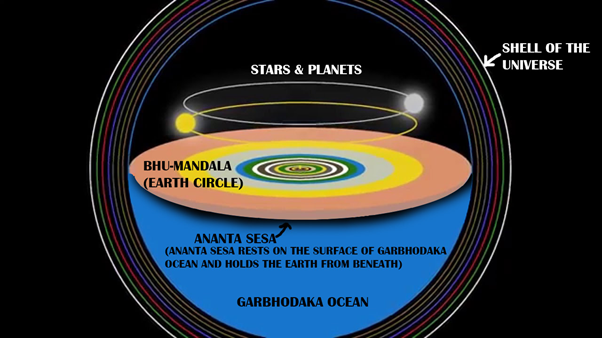
Ananta-sesha holding the Bhu-mandala from below
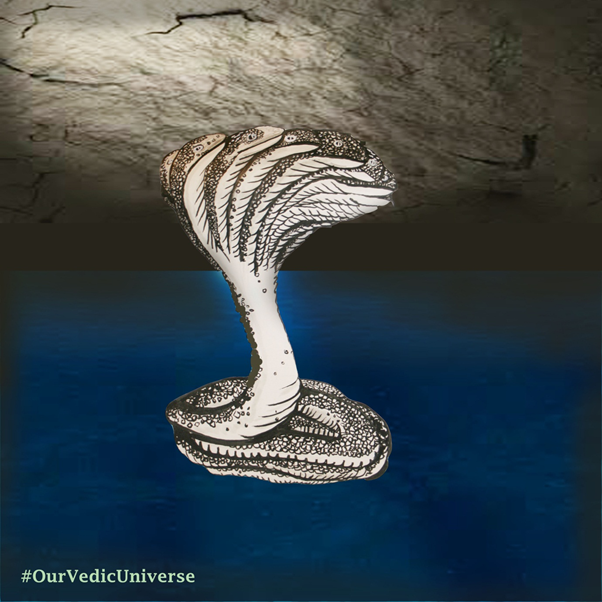
Ananta-sesha holding the Bhu-mandala from below
Due to the waters of devastation falling from above, the level of the Garbhodaka Ocean may have risen, thus covering the surface of the Bhu-mandala and submerging the Earth in the Garbhodaka Ocean. Lord Varaha then entered the Garbhodaka Ocean and raised the Earth again. As discussed already in SB 3.18.8, Lord Varaha first enabled the Earth to float on the surface of the Garbhodaka Ocean (whilst he fought with the demon Hiranyaksa). At some point after Hiranyaksa was killed, Ananta-sesha must have resumed His lila of holding the Bhu-mandala. I offer this explanation as a possibility, though I'm open to be corrected on the matter. In any case, Lord Varaha lifted the entire Bhu-mandala which is a massive circular plane; not a supposed Earth globe which is relatively small, and round like a ball.
Devotees may also come across statements such as the one below from Srila Prabhupada, and again doubts may arise regarding our argument that Varaha lifted the entire Bhu-mandala, and not a small round Earth globe. By referring to the 'Earthly planet' as 'round like a ball', Srila Prabhupada seems to suggest here that Varaha is lifting an Earth globe:
-
"How much big the Varaha animal was to show that it can pick up the whole earth, earthly planet just like a ball. He cannot imagine such big animals." (Philosophy Discussions: Discussion on Charles Darwin)
Here, of course, we get an image in the mind of Varaha lifting a globe or ball-shaped planet, but as we have already discussed, the idea of Varaha lifting an Earth globe is not supported in the original verses from Srimad Bhagavatam which clearly describe Varaha lifting the entire Bhu-mandala. In any case, any reference to the Earth in Srimad Bhagavatam must be understood in relation to the description of the Earth beginning at chapter 16 of the fifth canto. The full description of the Earth by Sukadeva Goswami leaves no room for thinking the Earth in Srimad Bhagavatam is described as a globe in space. Statements such as the above where Srila Prabhupada compares the Earth to a ball must be understood in proper context, not simply cited out of context as evidence that Srila Prabhupada was necessarily advocating an Earth globe concept. When we look at the context of the above conversation where Srila Prabhupada speaks of Varaha lifting the Earthly planet "just like a ball," we see that the conversation has nothing to do with a discussion on the details of Vedic cosmology. Srila Prabhupada is actually discussing the topic of evolution (not cosmology) and makes a point that the Vedas describe huge animals such as the Timingila fish. Srila Prabhupada then mentions the example of Lord Varaha who was so big that He could "pick up the whole earth, earthly planet just like a ball.' The preaching point here is to glorify the power of Varaha who is so great that he can lift the entire Earth; the preaching point is not to establish that the shape and size of the Earth is 'just like a ball.' As we discussed previously, the idea that the Earth is a planet floating in space and round like a ball, is not found in Srimad Bhagavatam; Srila Prabhupada is speaking of the Earth here merely in the conventional sense, not as the Srimad Bhagavatam actually describes it. When we go to the original verse, it is clear that Lord Varaha lifted the entire Bhu-mandala.
Outside of the specific context of the above conversation, the general context to understand all of such statements about the Earth is an appreciation of how Srila Prabhupada wanted the Temple of Vedic Planetarium to present the Srimad Bhagavatam's cosmology as it is. To present the fifth canto's cosmology as it is, requires that we present the Earth as it is described by Sukadeva Goswami. This description leaves no grounds for presenting the Earth in any other way, because presenting the Earth in any other way (such as an Earth globe floating in space) has nothing whatsoever to do with what Sukadeva Goswami describes as the reality of our situation. If we do not accept that Sukadeva Goswami is presenting the reality regarding the shape and size of the Earth, then what does that say about our faith in Srimad Bhagavatam? Is Sukadeva Goswami in illusion regarding the shape and size of the earth, or are we? Despite Srila Prabhupada speaking of the Earth using conventional terminology such as 'Earth globe' or 'Earth planet,' he nonetheless insisted time and again that his disciples present the Vedic cosmology within the TOVP "exactly to the description of the fifth canto."
-
Prabhupada: ...We are intending to make a huge planetarium. If you can help us?"
Tamala Krishna: Mentioning the Fifth Canto, Bhagavatam?
Prabhupada: Exactly to the description of Fifth Canto, we want.
(Room Conversation, May 8 1977, Hrishikesh)
Regarding the depiction of the Earth in the TOVP, in a letter to Mr. S.L Dhani, Srila Prabhupada writes:
-
"Now here in India, we are planning construction of a very large "Vedic Planetarium" or "Temple of Understanding". Within the planetarium we will construct a huge, detailed model of the universe as described in the text of the fifth canto of Srimad Bhagavatam..."
Srila Prabhupada then goes on to list 15 parts of the exhibition which will depict various areas of the material and spiritual world. Second on the list is the Earth or Bhu-mandala with its various features. Srila Prabhupada's letter reads as follows:
-
"The planetarium is planned to be approximately 400 feet high and will have floor space of approximately 90,000 sq. ft. The model will depict (from bottom to top)
1) The lower planetary system
2) The earthly system (Bhu-mandala with Sumeru in center, seven islands (saptadvipa), seven oceans (sapta-samudra), Manosattara Pravata, Lokaloka Parvata, Aloka-varsa.
3) The Bhuvarloka (Siddha-caranadi-loka)
4) etc…
(Letter to S.L. Dhani, November 14, 1976)
Here we see clearly that the Bhu-mandala concept of Earth is the one that Srila Prabhupada intended to be exhibited in the TOVP. The seven islands of Bhu-mandala are mentioned here. These islands form the inhabited area of the Earth and cover a distance of over 200 million miles. Jambudwipa is the first island of Bhu-mandala measuring 800,000 miles in diameter. Bharata-varsha is on the southern side of this super-continent. Bharata-varsha is thus on the plane of Bhu-mandala, not a separate planet floating in space. To accept that Bharata-varsha is on the plane of Bhu-mandala and not a planet floating in space is to accept the description as it is. Everything else is simply speculation.
LORD VARAHA IN SCULPTURE
We would like to turn now to an interesting discussion on the traditional depictions of Bhu-Varaha in sculpture and painting. In the book Varaha in Indian Art, Culture, and Literature (Aryan Books International, New Delhi, 1993) the author Shanti Lal Nagar discusses the many forms of Varaha that appear in ancient India culture. He divides these various forms of Varaha into six main categories: (i) Varaha (ii) Adivaraha, Bhuvaraha or Nrivaraha (iii) Yajnavaraha (iv) Pralayavaraha (v) Mahavaraha (vi) Varaha in boar form. In these six forms, the Lord appears in various poses. In some forms such as Pralaya Varaha, the Lord appears as a half-man half-boar form rising from the Garbhodaka Ocean with the personified Earth in his arms. Pralaya refers to the dissolution of the universe when it is devastated by water. In other forms the Lord also appears as half-man half-boar form, but seated on asana with the personified Earth on his thigh, or sometimes with both Lamxi and Bhu-devi sitting on each thigh. Some Deities show the Lord in the full boar form with no human features at all.
In Shanti Lal Nagar's wide survey of many ancient sculptures of the Varaha deity it is striking that there is no depiction of the Earth as a globe. In all of these ancient Deities, the Earth is always depicted in Her personified form as a female Goddess. Indeed, Shanti Lal Nagar quotes from the various shilpa shastras that would have been used to inform the craftsmen of how the deity is to be depicted. For example, the figure of Bhu-Varaha should be depicted in the following way according to Vaikhanasagama:
-
"The figure of Bhuvaraha should have, according to Vaikhanasagama the face of a boar in association with the body of a man. It should have four arms, two of which should hold a conch-shell and the chakra. The right leg should be slightly bent and be made to rest upon the jewelled hood of the mythical serpent Adisesa, who should be sculptured in the company of his spouse. Of the remaining two hands, the left should be shown as supporting the legs of BhudevI, seated on the God's bent right leg with her legs hanging down. The right hand of the god has to be shown embracing the waist of the goddess. The boar-face of the god should be slightly tilted up so as to bring the muzzle into close proximity of the bosom of the goddess as though he is engaged in smelling her. The colour of the image of Varaha-Visnu is represented by the darkness of twilight. The associated figure of BhudevI should hold her hands in ahjali pose. She should be decked with flowers, clothes and adorned with suitable ornaments. Her complexion has to be black. Her face should be slightly lifted up and turned towards her lord in an expression of joy coupled with shyness. The top of her head should reach the chest of the figure of Varaha and her image should be made with the pahchatala measure."
As an aside it is interesting here that Varaha is to be depicted as if smelling the Earth. The Srimad Bhagavatam describes how Varaha searched after the submerged Earth by means of smell: "He was personally the Supreme Lord Vishnu and was therefore transcendental, yet because He had the body of a hog, He searched after the earth by smell. His tusks were fearful, and He glanced over the devotee-brahmanas engaged in offering prayers. Thus He entered the water. (SB 3.13.28))
Continuing on; the Pralayavaraha form of Varaha is depicted differently from the Bhu-varaha form and is described in the following way:
-
"The complexion of Pralayavaraha has to be blue. The image has to be clothed in yellow garments and decked with all usual ornaments. On the right of the Pralayavaraha, on the same seat Bhudevi should be placed with her right leg hanging down and the left one bent and made to rest on the seat. She has to be dark in complexion and should be wearing all the usual ornaments. In her left ear, there should be an ornament. In her left hand, there should be an utpala flower and her right hand should be resting on the seat. She should be made to look at her lord with amazement which should be reflected in her eyes."
What is significant in these descriptions are the various detailed postures of the personified Earth:
-
"Yajnavaraha: This form of Varahamurti according to the Vaikhanasagama, has to be of white complexion and should have four arms, two of which are to carry a samkha and the chakra. The figure should be seated over a Sirhhasana with the right leg hanging down and the left resting upon the seat. He should be clothed in yellow garments and adorned with various ornaments. On the right side should be seated the figure of Laksmi having the golden yellow colour. Her left leg should be bent and kept resting upon the seat, while the right one should be left hanging. Her left hand should carry a lotus and the right hand should be resting on the seat. On the left on Yajnavaraha murti, there should be a seated Bhudevi of dark complexion, with her right leg bent and resting upon on the seat and the left leg hanging down. In her right hand she should hold a nllotpala flower and the left hand should rest on the seat. The face of the goddess has to be slightly turned towards the god wearing an expression of surprise."
Again:
-
"Pralayavaraha: On the right of the Pralayavaraha occupying the same seat should appear his consort Bhudevi, with her right leg hanging down and left bent and made to rest on the seat. She has to be dark in complexion and should be bedecked with all the usual ornaments. In her left hand there should be an utpala flower and her right hand should be resting upon the seat. She must be made to look at her Lord with amazement which should be fully projected in her eyes."
Again:
-
"Mahavaraha: The Matsya Purana (260-28-30) informs that Mahavaraha should carry a mace and lotus in his hands, while one of his legs should be placed over Kurma and the other on Adisesa. Prthvi should be seated on his snout or his elbow, carrying nllotpala flower in one of her hands. The other should be placed on her hip."
We can see from the following images (see below) how Bhu-devi (the personified Earth) was carved strictly following the original guidelines and descriptions in the various shilpa shastra (texts that deal with the creation of scared murtis, architecture, painting, etc). I mention this because as we shall see later, the modern sculptures of Varaha depict the Lord holding an Earth globe. The depiction of Varaha holding an Earth globe is thus not only a major deviation from the original Puranic texts that describe the Earth as a great circular disc, but also from the shilpa shastra that instruct how to depict the Earth in her personified form.
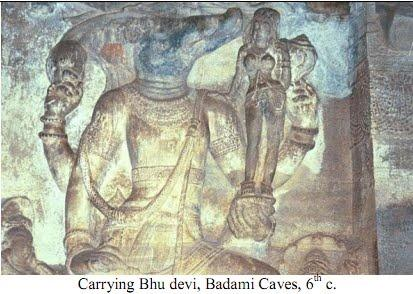
Bhu-Varaha at Badami Caves, 6th Century
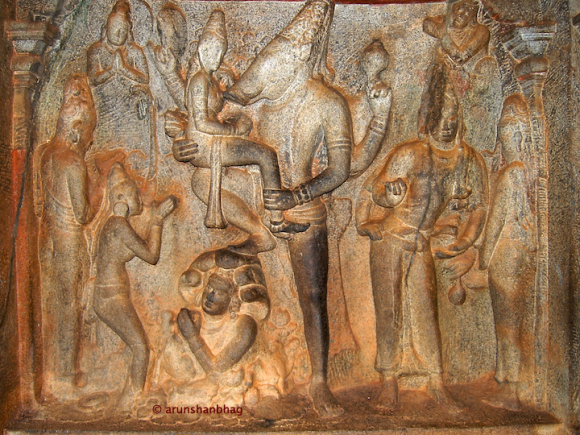
Bhu-Varaha at Mamallapuram, 6th Century
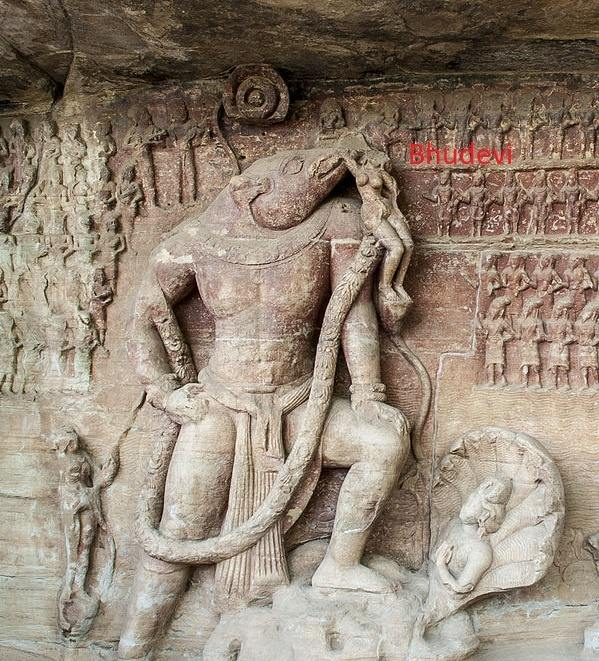
Bhu-Varaha at Udayagiri Caves 5th Century
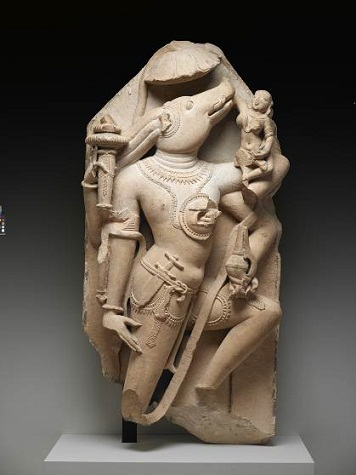
Bhu-Varaha, 10th Century, Dallas Museum of Art
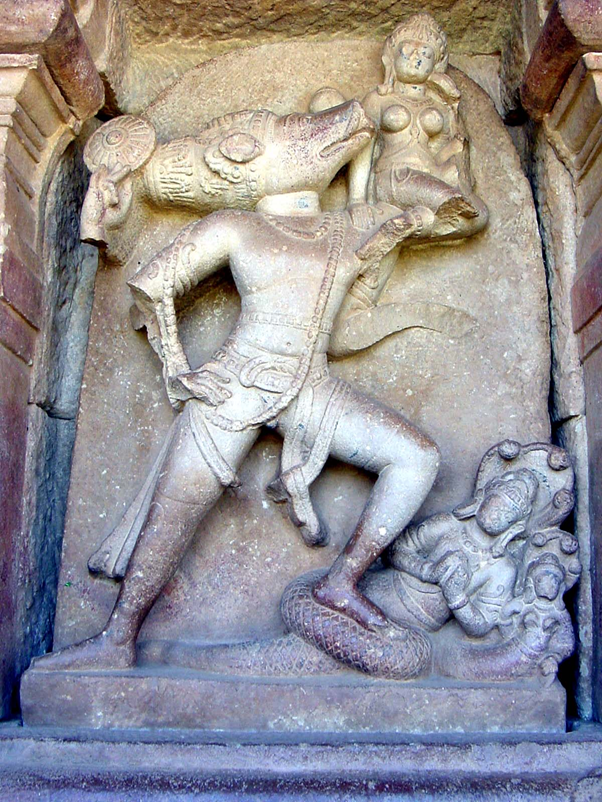
Bhu-Varaha. Durga Temple, Aihole, Karnataka 6-8th Century
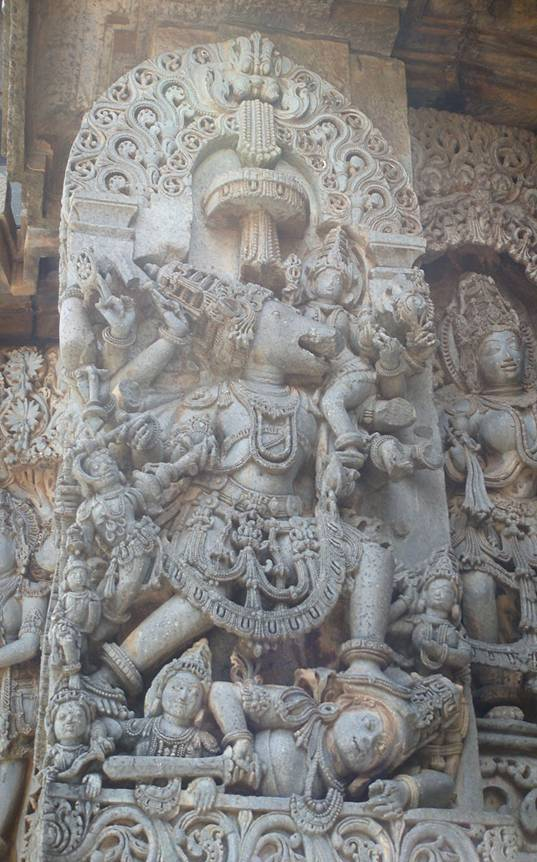
Hoysaleswara Temple, Karnatka, 12th Century
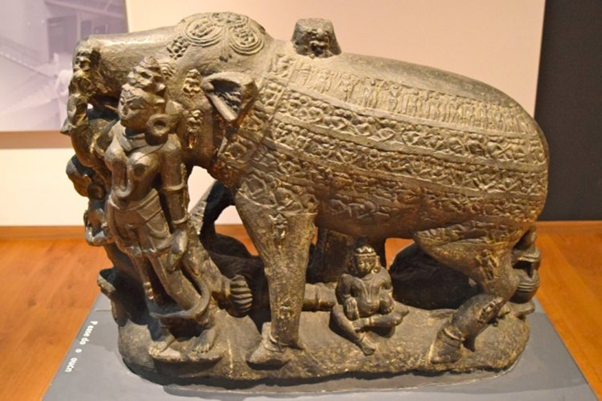
Bhu-Varaha, 9th century, Ashmolean Museum, Oxford
The massive deity of Bhu-Varaha at Kalahalli in the image below was said to be installed 2,000 years ago by the sage Gautama and the Deity is still being worshiped today:
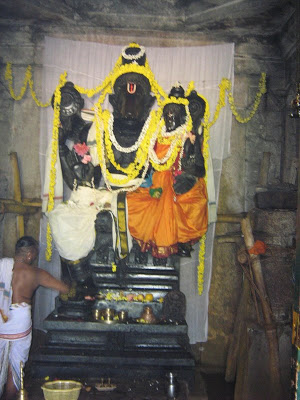
Bhu-Varaha at Kalahalli
The Varaha Deity at Kalahalli is 15 feet tall and Bhu Devi is 3.5 feet and is seated in his left thigh.
We can see from all of the above images that Bhu-devi was historically depicted in her personified form. Such murtis would have strictly followed the original guidelines and descriptions in the various Puranas and shilpa shastra. Of course, seeing a deity of Bhu-devi (the personified Earth) in her female form does not bring us any closer to understanding the shape and size of Bhu-devi in her form as the Earth's great landscape. To understand the size and characteristic of the Earth's landscape with features such as the seven great islands and oceans we have to consult Srimad Bhagavatam and other Puranas. For our benefit, Pariksit Maharaja raised the question of the Earth's shape and size during his discourse with Sukadeva Goswami. In Srimad Bhagavatam, Canto 5, Chapter 16, verses 1-2, Maharaja Pariksit requests his guru Sukadeva Goswami to describe the measurements and qualities of the seven islands and oceans of Bhu-mandala:
-
"King Pariksit said to Sukadeva Gosvami: O brahmana, you have already informed me that the radius of Bhu-mandala extends as far as the sun spreads its light and heat and as far as the moon and all the stars can be seen.
My dear Lord, the rolling wheels of Maharaja Priyavrata's chariot created seven ditches, in which the seven oceans came into existence. Because of these seven oceans, Bhu-mandala is divided into seven islands. You have given a very general description of their measurement, names, and characteristics. Now I wish to know of them in detail. Kindly fulfil my desire." (SB 5.16.1-2)
This is a very specific question requesting 'measurements' and 'characteristics', and the name Bhu-mandala is particularly invoked, along with its characteristic central feature of seven islands (sapta-dwipa) and seven oceans (sapta-sindava). In reply to this question, Sukadeva Goswami states that there is no end to the Lords material energy, but that he will try to explain the principle regions of the Earth (Bhu-gola).
-
"The great Rsi Sukadeva Gosvami said: My dear King, there is no limit to the expansion of the Supreme Personality of Godhead's material energy. This material world is a transformation of the material qualities [sattva-guna, rajo-guna and tamo-guna], yet no one could possibly explain it perfectly, even in a lifetime as long as that of Brahma. No one in the material world is perfect, and an imperfect person could not describe this material universe accurately, even after continued speculation. O King, I shall nevertheless try to explain to you the principal regions, such as Bhu-goloka [Bhuloka], with their names, forms, measurements and various symptoms." (Sb 5.16.4)
bhu-golaka-visesam—the particular description of Bhuloka; nama-rupa—names and forms; mana—measurements; laksanatah—according to symptoms; vyakhyasyamah—I shall try to explain.
From this point in the discussion, Sukadeva Goswami's begins his epic description of the great Earth circle with all her amazing and gigantic features. This description of the Earth covering ten chapters of the fifth canto leaves no room for speculation regarding the size, shape, and characteristics of the great Earth circle and our own place upon it (in the area of Bharata-varsha). Thus, when the modern sculptures and paintings of Varaha depict the Lord holding an Earth globe, we must raise the obvious question of where the idea of depicting Varaha lifting a globe-shaped Earth actually came from; and is this idea of the Earth a deviation from Vedic teachings? Certainly, the depiction of Varaha holding an Earth globe is a major deviation not only from the original Puranic texts that describe the Earth as a great circular disc, but it is also a deviation from the shilpa shastra that give clear and detailed instructions to depict the Earth in her personified form. One will not find an ancient Vedic text that instructs the craftsmen to sculpt Varaha holding an Earth globe because, of course, the Puranas describe the Earth in a radically different way.
The idea of Varaha saving the Earth appeals to one's love of nature and the many obvious environmental concerns that we all share for the beautiful Earth. To celebrate Lord Varaha's appearance day is a way to show our appreciation to the Lord as the protector of the Earth. In 2014, we had the great privilege to partake in the Varaha-dvadasi festival at Sri-Dhama Mayapur. I remember it as a greatly blissful festival and was swept up in the happiness and great devotional mood created by the service and worship of so many devotees. The beautiful abhiseka ceremony of Lord Varaha with mountains of flowers and other offerings was splendid in every way. I mention this festival because the fact that the Varahadeva Deity at Mayapur appears holding an Earth globe on his nose did not distract in any way from the otherwise wonderful festival. In fact, I had no idea at the time that the Earth could be anything other than an Earth globe.
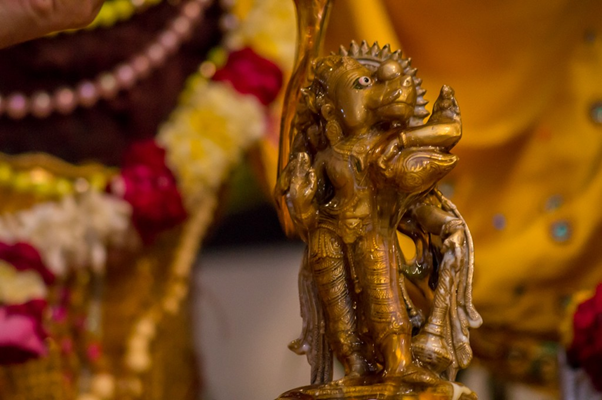
Abhisheka of Lord Varaha holding a globe on Varaha Dvadasi (2013) in Sri Dhama Mayapur
My question, though, is what basis does this particular depiction of Lord Varaha holding a globe-shaped Earth have in either Srimad Bhagavatam or the shilpa shastra? When we see this globe-shaped Earth held in the tusks of Lord Varaha, the relevant question for a student of Srimad Bhagavatam to ask is: does such a concept have any reference in Srimad Bhagavatam? What is this globe-shaped Earth referring to in Vedic cosmology? Does the globe shape, for example, refer to Bharata-varsha? As we know, Srila Prabhupada sometimes identifies the Earth with Bharata-varsha:
-
"Actually, Bharata-varsha is the name for the entire planet, but gradually Bharata-varsha has come to mean India." (SB 3.18.19 purport)
"King Bharata was the emperor of the world, and since his time this planet has been known among the demigods as Bharata-varsa." (Bhagavad-gita 6.43)
"Rsabhadeva was the son of King Nabhi and the grandson of King Agnidhra, and he was the father of King Bharata, after whose name this planet earth was called Bharata-varsha." (SB 2.7.10)
Again, Srila Prabhupada is simply helping us to understand our whereabouts in the Vedic universe: he is letting us know that we are in Bharata-varsha which is part of Bhu-mandala (the Earth). For simplification, Srila Prabhupada conflates Bharata-varsha with 'this planet Earth.' However, If one is unaware of the description of the Vedic Earth (Bhu-mandala), and specifically the location of Bharata-varsha upon the surface of Bhu-mandala, then one may misunderstand the subject and think that Srimad Bhagavatam describes Bharata-varsha as an Earth globe floating in space. Bharata-varsha is nowhere described in the Puranas as a globe in space, and is otherwise described as one of the nine areas of Jambudwipa, the central island of Bhu-mandala. One has to go deeper into the study of Bharata-varsha and it's location in Jambudwipa:
-
"Bharata-varsha: This part of the world is also one of the nine varshas of the Jambudvipa." (SB 1.16.12 purport)
This description of Bharata-varsha's location in Jambudvipa raises obvious doubts in our present understanding that we live on a globe. In other words, since Bharata-varsha is located on the southern side of Jambudvipa and (hence on the vast plane of Bhu-mandala), it cannot be regarded as a separate Earth planet floating in space—that is not what is being described! Just as Italy is south of Europe and part of the same Earth plane, so Bharata-varsha is south of Jambudwipa and likewise part of the same Earth plane. Bharata varsha is actually described in the Puranas as being bow-shaped, not globe-shaped due to its position on the southern coast of Jambudwipa. The great Himalaya Mountain on the northern border forms runs for 480,000 miles and forms the string of the bow; the curve of Jambudwipa's coast forms the bow shape, as indicated by the red line in the image below. The continents of our known Earth (Arctic, Antarctica, North and South America, Europe, Asia, and Australia) would form just a tiny part of this Bharata-varsha area:
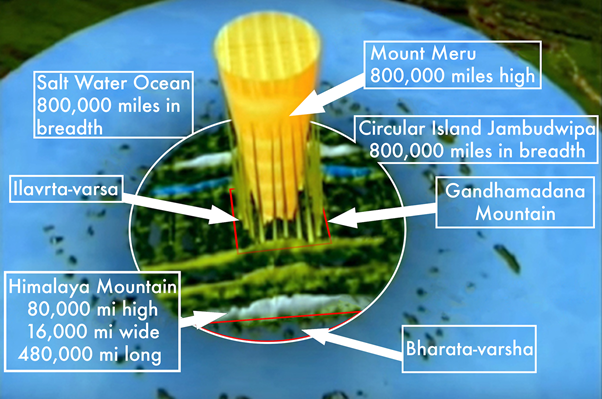
The bow-shaped Bharata-varsha
So if the globe on Varaha's tusks does not represent Bharata-varsha, then what does it represent? Srila Prabhupada also identifies Bhu-mandala with the Earth globe or Earth planet, and thus one may get the impression that the globe represents Bhu-mandala:
-
"After this, the king of all kings, Maharaja Prthu, leveled all rough places on the surface of the globe (bhu-mandalam)" (SB 4.18.29)
However, the Bhu-mandala is not globe–shaped. Bhu-mandala is described as a circular-shaped plane that is 4 billion miles in diameter, not a globe-shaped ball that is 24,900 miles in circumference. So neither the descriptions of Bharata-varsha or Bhu-mandala actually match with the Earth globe concept. The depiction of Varaha holding an Earth globe is thus simply the imposition of our modern idea of what the Earth looks like, but this modern conception has nothing at all do with the Srimad Bhagavatam's original description of what the Earth looks like. Over the past few hundred years Vaishnavas have been led to believe that the Earth is a globe, despite the Srimad Bhagavatam describing the Earth in a radically different way. The Temple of Vedic Planetarium is manifesting to reveal the truth of the situation. It may take some time for everyone to overcome their conditioning that we live on an Earth globe floating in space; but hey—overcoming conditioning is what we are here for after all!
Of the many ancient Varaha deities that are presented in Shanti Lal Nagar's book and of the many hundreds of images of ancient Varaha deities that are posted online, Bhumi is always depicted in her personified form. However, there are a few on-line images of sculptures showing Varaha apparently holding a globe on his tusks:
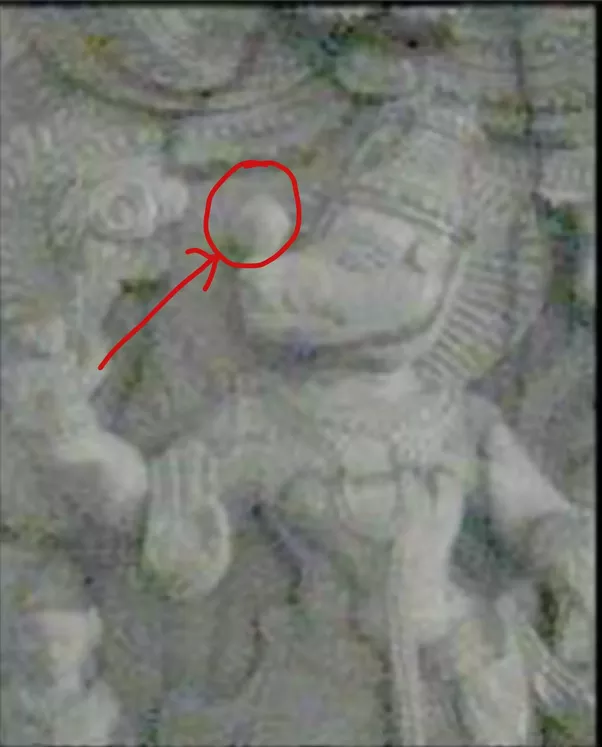
Unfortunately, the picture is very hazy and there is no accompanying information as to the age of the sculpture or the particular temple where it is to be found. The photograph only shows part of Varaha, and one can't tell if Bhumi in personified form also appears anywhere in the sculpture. My guess is that this a modern sculpture since it has no equivalent in the huge array of ancient Varaha sculptures that strictly follow the shastras procedure for depicting Bhumi in personified form. Temple sculptures or murtis of Varaha holding a globe-shaped Earth seem to have appeared only in recent times, and pay no regard to the traditional manner of depicting Bhumi in personified form.
In the second picture below the sculpture of Varaha lifting a globe appears to be of recent origin. Again, I couldn't find any additional information, but I present the image, nonetheless, so that devotees can begin to ask relevant questions regarding such images when they appear as so-called 'proofs' for the globe. The most important questions are obviously when was the sculpture carved; and on what shastra is it based? We contend that any sculpture of Varaha holding a globe is of relatively recent origin and simply the result of the contamination of modern ideas regarding the Earth that was introduced to India at various historical points. Certainly the image of Varaha in the picture below does not appear to be weathered, and looks more like a sculpture from a modern temple:
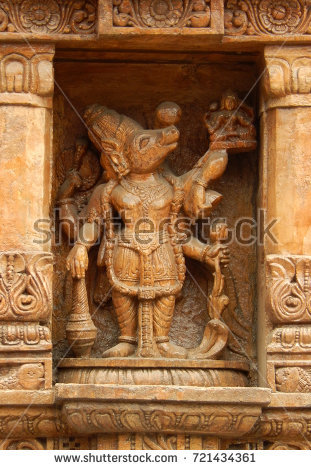
Again this depiction of Varaha is of very recent origin:
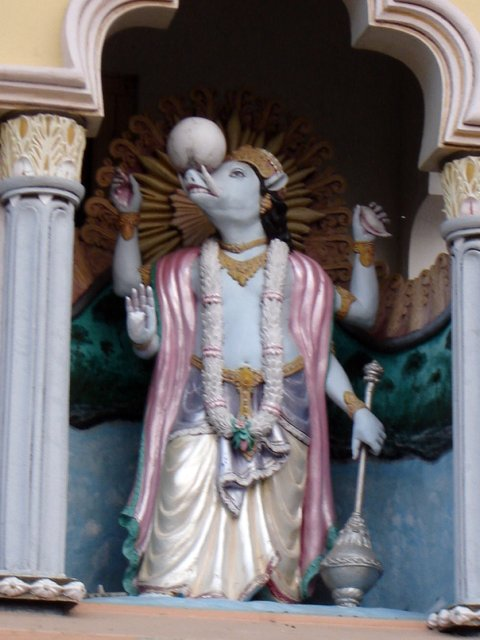
The murti below of Varaha holding a globe is described as 'Bhu-varaha brass idol' and sells for RS 2,880.00.
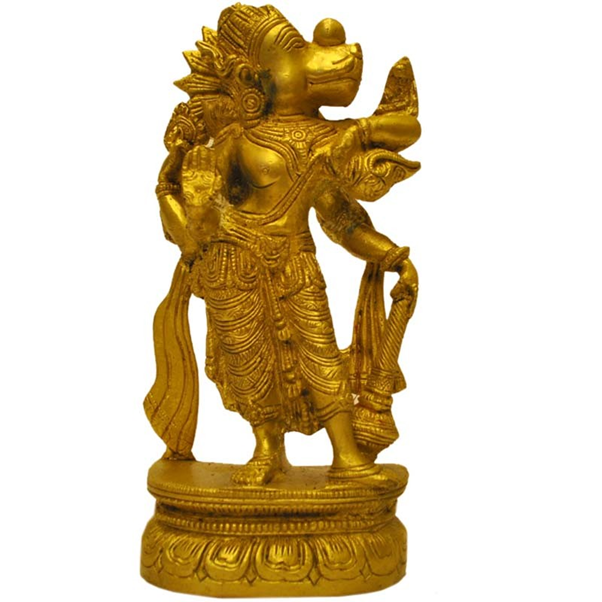
Along with the images of the temple sculptures shown above, this modern murti of Varaha carrying a globe on His snout is practically enough to convince an innocent bhakta that Varaha indeed lifted an Earth globe. But what is the image based on? The idea that Varaha lifted a 24,900 mile Earth globe from the Garbhodaka Ocean and then set it in space has no basis in shastra whatsoever. That's not what Varaha-lila describes! Varaha-lila describes the Lord raising the entire Bhu-mandala from the Garbhodaka ocean. The idea that Varaha lifted an Earth globe is simply a result of mixing the Western idea of 'the Earth' into the original Vedic conception.
Thankfully, many of the modern deities still follow the shilpa shastra and are made with Bhumi depicted in her personified form:
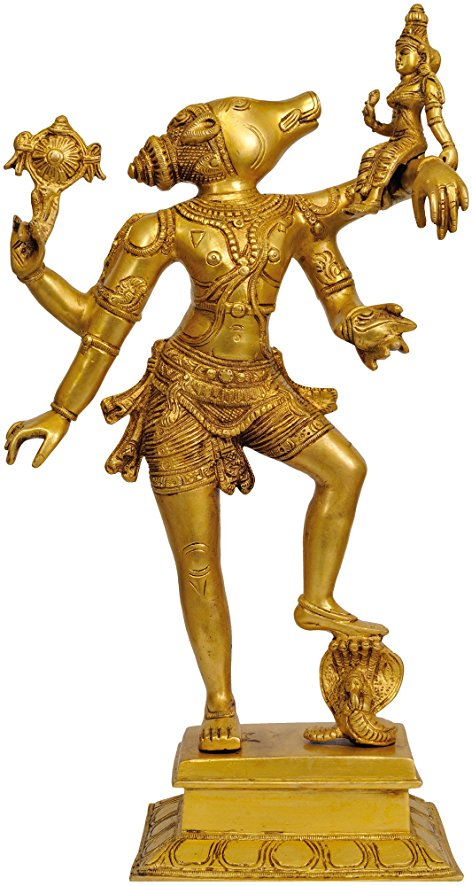
I have stated above that the depiction of Bhumi as a globe is a 'deviation' from the original Vedic description of the Earth. Since Srila Prabhupada referred to the Earth as a globe, one could allege that we are accusing Srila Prabhupada of deviating from the Vedic world-view. Before anyone attempts to twist my words and intention by falsely accusing in this way, let me explain that we have already clearly established a number of facts on this issue (1) There is no description of an Earth globe floating in space in the Srimad Bhagavatam, and that the Earth is described in a radically different way. (2) Although Srila Prabhupada began the revival of Vedic cosmology in the modern world, a comprehensive study of Bhu-mandala had not been completed by the time of Srila Prabhupada's departure in 1977. In the absence of a comprehensive conception of Bhu-mandala, Srila Prabhupada had simply spoken of the Earth in the conventional understanding as a globe in space (3) Despite speaking of the Earth in the conventional language of 'globe' and 'planet', Srila Prabhupada's emphatic instruction was to depict the Earth exactly according to Srimad Bhagavatam, and 'to bring people to that idea'.
-
Prabhupada: We shall show the Vedic conception of planetary system within this material world and above the material world. [break] We are going to exhibit the Vedic culture throughout the whole world, and they'll come here…Actually it will be an unique thing in the world. There is no such thing all over the world. That we shall do. And not only simply showing museum, but educating people to that idea." (Morning Walk, Feb 27, 1976, Mayapur)
Since the Earth of Srimad Bhagavatam is described as a great circular disc, we have to bring people 'to that idea'. Bringing people to the idea of Bhu-mandala obviously requires challenging all contemporary science, images, and assumptions that we live on a globe.
LORD VARAHA IN ART
We will now look at some ancient paintings that show Varaha lifting the flat Earth. Some of these paintings date back to the middle of the seventeenth century. Even to the present day many Indian artists continue to paint Varaha holding the flat Earth. The ancient paintings are obviously based on a shared belief that the Earth is not globe-shaped. If the ancient scriptures had presented the idea that the Earth is a globe, then painters would have depicted it as such. Instead, we have the Earth depicted as a flat plane. Where did such an idea come from? The idea that the Earth is a flat stationary plane is found in all ancient cosmologies, including the Vedic cosmology. It is only in recent times that the Earth has been depicted as a globe-shaped.
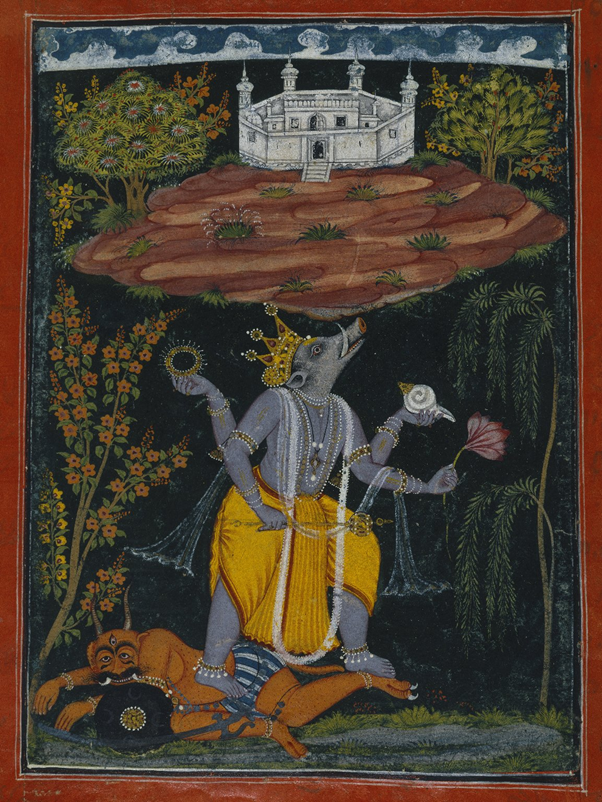
Viraha, c. 1730
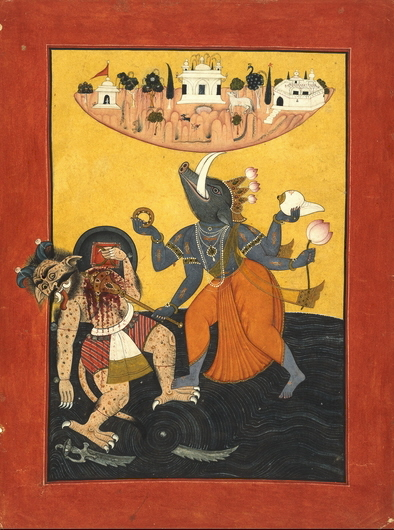
Viraha, c. 1740
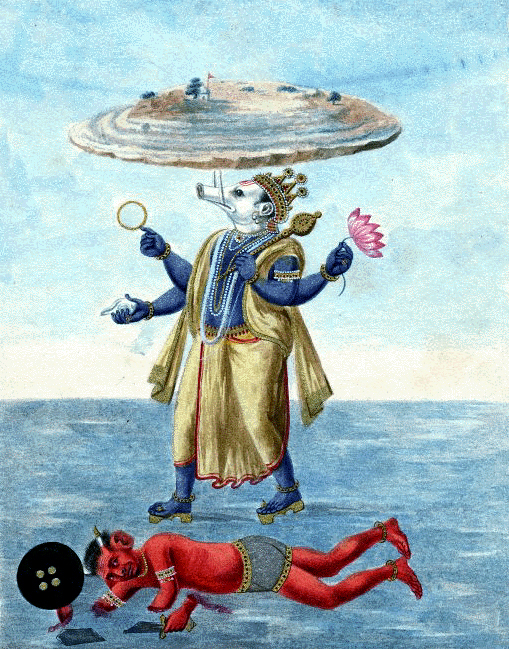
Viraha, c. 1800
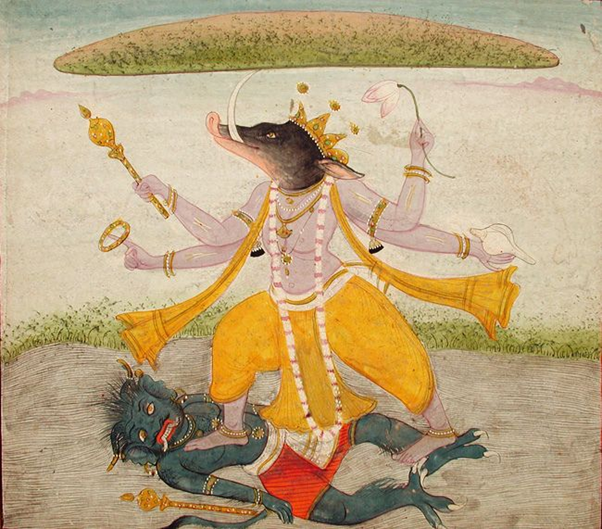
Viraha, c. 1850
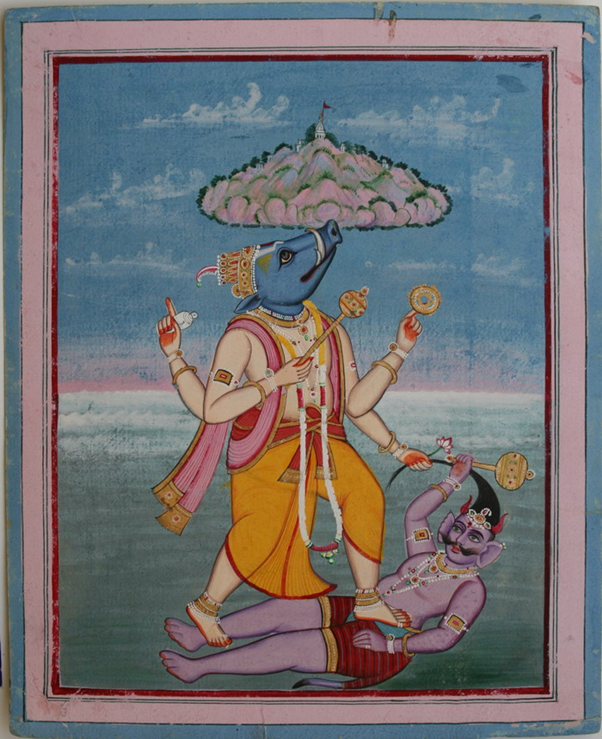
Viraha, c. 1860
These historical images of Varaha obviously depict the flat-Earth. Why would artists paint the flat-Earth if they believed the Earth was a globe? The artists involved in creating sacred images are obviously following the religious world-view of the time. This world-view was created by the Vedic conception, and only in modern times has this conception been overturned with modern images such as the one below that have no basis in shastra:
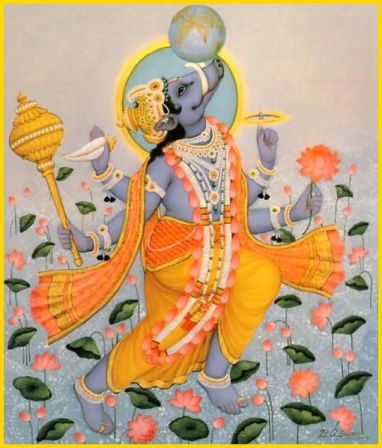
Below is a painting by a contemporary Indian artist called Kaliash Raja who continues to depict Bhumi as the flat Earth:
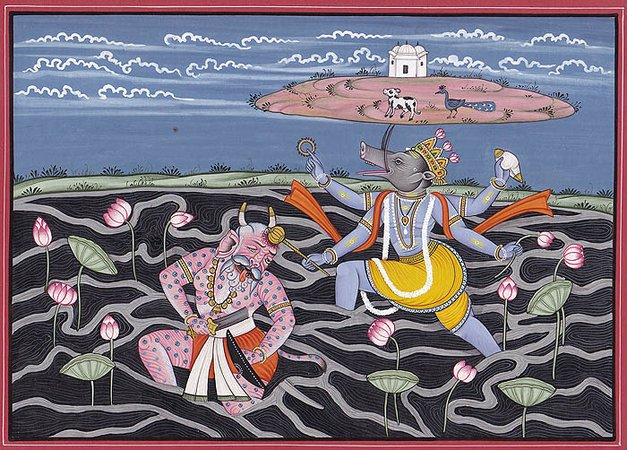
Although the above paintings all depict the Earth as a flat circular plane, one curious feature of the above images is that the artists do not show any understanding of the main features of Bhu-mandala such as Mount Meru in the center of the Earth, surrounded by the seven islands and oceans in their unique concentric formation.
WAR ON ILLUSION
The following section is from one of our previous articles on Lord Varaha:
A doubt in the flat Earth idea obviously arises when one considers the possibility and likelihood of anyone being able to cover the real feature of the Earth. Could the asuras be really so bold and expert as to fake the very shape and size of the Earth itself? Actually, this potency has more to do with the arrangement of maya: due to the progression of Kali-yuga, Vedic knowledge is withdrawn and maya engages various agents to bewilder everyone about the nature of reality. By the process of mental speculation and pseudo-science (Copernicus, Galileo, and Newton) one can easily become bewildered about what is real and what is unreal regarding the Earth's true nature. Most people have never conducted their own research into the validity of such ideas such as heliocentricity and gravity, but simply accept the standard version of reality. More recently, by the usage of photography and television (tell-lie-vision), the asuras can make anything appear possible, such as a supposed landing on the surface of the moon with astro-nots snapping pictures of a so-called 'Blue Marble' (the Earth) which is seen floating in space some hundreds of thousands of miles away. Bear in mind that by the grace of maya, asuras are also expert in creating illusion. Consider the following narration describing Lord Varaha and Hiranyaksa as they fought for the Earth:
-
"O descendant of Kuru, Brahma, the most independent demigod of the universe, accompanied by his followers, came to see the terrible fight for the sake of the world between the demon and the Personality of Godhead, who appeared in the form of a boar." (SB 3.18.20)
"Lord Brahma continued: My dear Lord, there is no need to play with this serpentine demon, who is always very skilled in conjuring tricks and is arrogant, self-sufficient and most wicked." (SB 3.18.24)
Here Brahma refers to Hiranyaksa as maya-vinam - skilled in creating illusions. Bear this in mind the next time you see astro-nots in space: are they actually in space looking down upon the globe Earth, or have they simply created the illusion of being in space using clever special effects and other tricks in studios here on Earth? There are many statements wherein Srila Prabhupada questions the authenticity of images presented by so-called space agencies:
-
Ramesvara: They're convinced by the photographs.
Prabhupada: Eh?
Ramesvara: They have some photographs of the men in the spacesuits walking around on that other planet.
Kirtanananda: But they are convinced because the scientists have told them. They believe the scientists. They have faith, and the scientists can tell them anything, and they'll believe it.
Prabhupada: Yes, that is.... That is the disease.
(Morning Walk, June 11, 1976, Los Angeles)
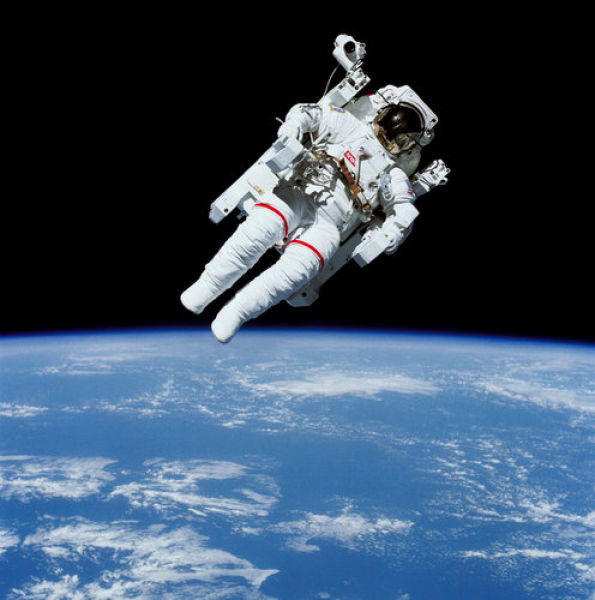
Made in PaintShop
-
Prabhupada: Cheating. You know, there are companies. They'll... They have got photographic studio. So they adjust their moon hoax. They'll help you. If you have got particular idea... They are going to the moon planet, Mars. Nowhere the rascals go. There is no knowledge. How they can go? Teeny, imperfect. So if we can prove that they have no knowledge of the universe, neither of the position of their..."
Svarupa Damodara: Actually if these two things, that life comes from life and this concept of the universe, two points are clear, then everything is taken care of.
Prabhupada: Very good. Their false propaganda...
(Room Conversation with Swarup Damodar, June 21, 1977, Vrindavana)
'False propaganda' regarding the nature of the universe obviously requires the use of sophisticated forms of illusion. Since truth is not a consideration for the demons, they become expert in creating illusion for the purpose of deluding, controlling, and exploiting others. The demon Hiranyaksa is described here as expert in creating illusion:
-
"The demon, however, employed many conjuring tricks against the Personality of Godhead, who is the Lord of yogamaya. At the sight of this the people were filled with alarm and thought that the dissolution of the universe was near." (SB 3.19.17)
The words used here are athorudhasrjan mayam yoga-mayesvare harau, meaning that although the demon Hiranyaksa could also create maya or illusions (athorudhasrjan mayam), his illusions could not defeat Lord Hari who is described as yoga-maya-isvara—the Lord of illusion. In the above verse Lord Varaha is glorified as yoga-mayesvare harau. We should understand that same yoga-mayesvare is presently appearing in the form of the Hare Krishna maha-mantra in order to again save the world from the Hiranyaksas who are bent on destroying it:
"kali kale nama rupe krsna avatara
nama haite haya sarva jagat nistara"
"In this Age of Kali, the holy name of the Lord, the Hare Krsna maha-mantra, is the incarnation of Lord Krsna. Simply by chanting the holy name, one associates with the Lord directly. Anyone who does this is certainly delivered." (Caitanya Caritamrta, Adi-lila, 17.22)
As the sun rises dispersing darkness, so the sound incarnation of Godhead (Hare Krishna mantra) is presently dispersing all illusions, deceptions, and untruths that have upheld the asuric system of government for the last few thousand years.
-
"Whenever and wherever there is a decline in religious practice, O descendant of Bharata, and a predominant rise of irreligion—at that time I descend Myself.
To deliver the pious and to annihilate the miscreants, as well as to reestablish the principles of religion, I Myself appear, millennium after millennium." (Bhagavad-gita As It Is 4.7-8)
Through the medium of Srimad Bhagavatam and the Temple of Vedic Planetarium, the Lord of all mystic yoga will eventually disperse the asuric illusions that cover the true nature of the Earth. Part of the asura's deceit is to hide the truth of Krishna's creation from the mass of people who are thereby kept in ignorance and fear so that they can be easily controlled and exploited. This deception is ultimately directed by maya, and the asuras are mere instruments of karma in causing further delusion to those souls who have rejected a God-centered world in favour of a self-centered one. In any case, the appearance on the Earth of the Lord or his representative changes everything for all beings suffering under the present asuric system.
-
"The fight between the Lord, the Supreme Personality of Godhead, and the demon is compared to a fight between bulls for the sake of a cow. The earth planet is also called go, or cow. As bulls fight between themselves to ascertain who will have union with a cow, there is always a constant fight between the demons and the Supreme Lord or His representative for supremacy over the earth." (SB 3.18. 21)
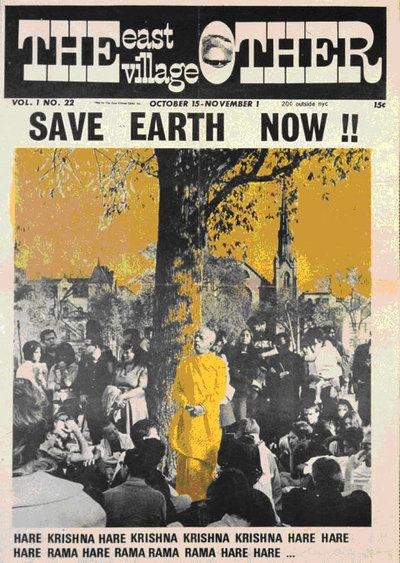
One should have faith that Krishna has presently manifested in the form of the Hare Krishna maha-mantra in order to save the Earth once again. Part of the on-going rescue of those living under the illusions and subjugation of the present asuric system will be an exposure of the lies surrounding the nature of the Earth that we live upon. Since Srimad Bhagavatam clearly describes that we live on an Earth plane (and not an Earth globe), we hope that the message preached from the Temple of Vedic Planetarium will be consistent with the original description.
Paintings of Lord Varāha-Deva lifting flat earth-plane
